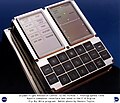Fájl:Apollo display and keyboard unit (DSKY) used on F-8 DFBW DVIDS683588.jpg

Az előnézet mérete: 765 × 600 képpont További felbontások: 306 × 240 képpont | 612 × 480 képpont | 980 × 768 képpont | 1 280 × 1 004 képpont | 2 560 × 2 007 képpont | 3 030 × 2 376 képpont.
Eredeti fájl (3 030 × 2 376 képpont, fájlméret: 6,18 MB, MIME-típus: image/jpeg)
Fájltörténet
Kattints egy időpontra, hogy a fájl akkori állapotát láthasd.
| Dátum/idő | Bélyegkép | Felbontás | Feltöltő | Megjegyzés | |
|---|---|---|---|---|---|
| aktuális | 2021. október 9., 08:29 |  | 3 030 × 2 376 (6,18 MB) | Huntster | Cropped 9 % vertically using CropTool with lossless mode. |
| 2021. október 9., 08:28 |  | 3 030 × 2 606 (5,97 MB) | Huntster | Full resolution from NASA. | |
| 2015. május 6., 02:42 |  | 1 536 × 1 321 (303 KB) | Fæ | == {{int:filedesc}} == {{milim | description = {{en|1=The display and keyboard (DSKY) unit used on the F-8 Digital Fly-By-Wire (DFBW) aircraft during Phase I of the fly-by-wire program. Warning lights are in the upper left section, displays in the uppe... |
Fájlhasználat
Az alábbi lap használja ezt a fájlt:
Globális fájlhasználat
A következő wikik használják ezt a fájlt:
- Használata itt: ar.wikipedia.org
- Használata itt: en.wikipedia.org
- Használata itt: es.wikipedia.org
- Használata itt: fi.wikipedia.org
- Használata itt: fr.wikipedia.org
- Használata itt: he.wikipedia.org
- Használata itt: ja.wikipedia.org
- Használata itt: pl.wikipedia.org
- Használata itt: ru.wikipedia.org
- Használata itt: uk.wikipedia.org


